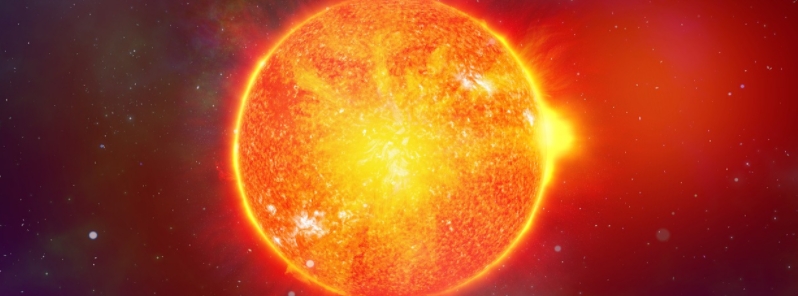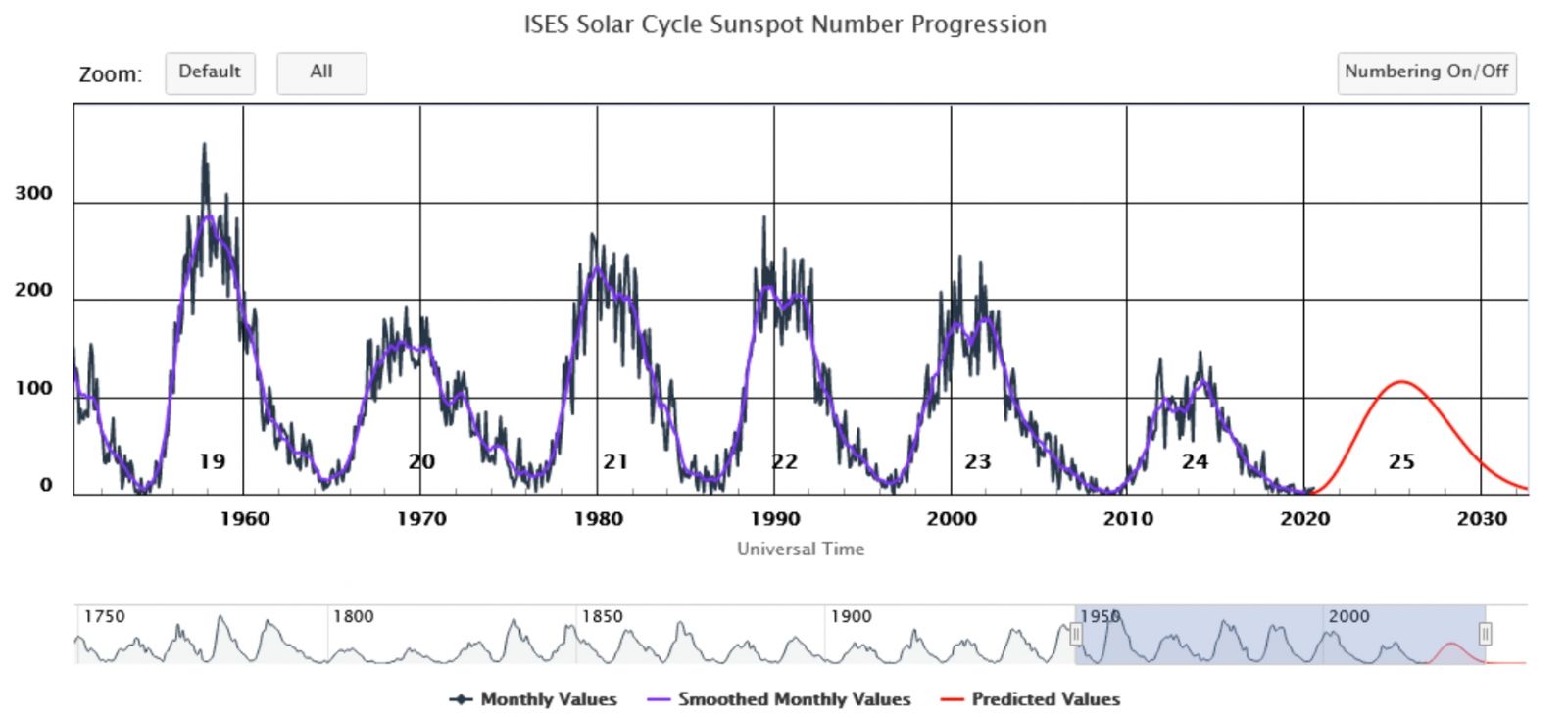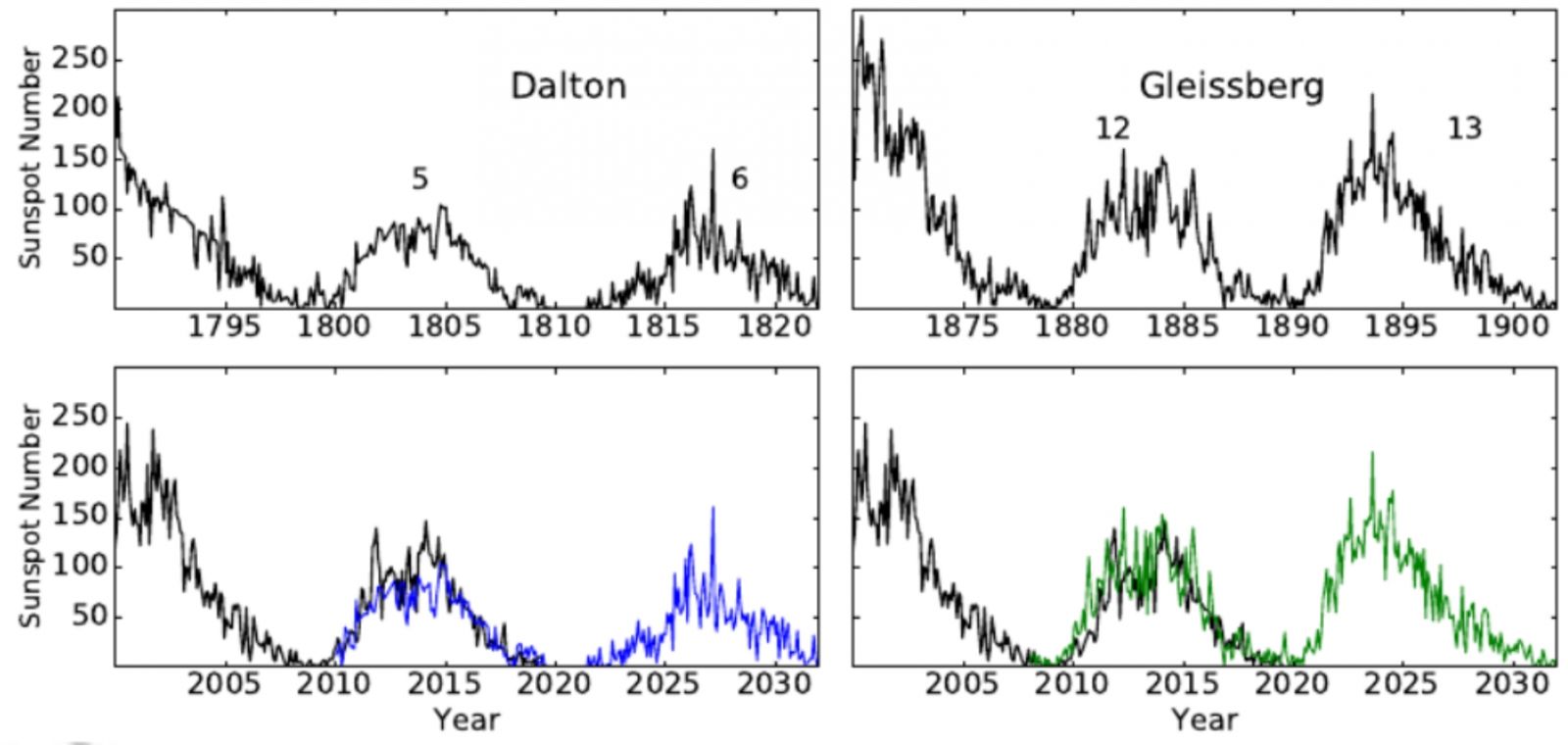Cosmic rays increase remarkably as solar activity shows persistent decline, resembles Dalton minimum of 1790 – 1830

Recent solar conditions indicate a persistent decline in solar activity‐‐‐possibly similar to the past solar grand minima, scientists reporting in AGU's Space Weather write. During such periods of low solar activity, the fluxes of galactic cosmic rays (GCRs) increase remarkably, presenting a hazard for long‐term crewed space missions and affecting Earth's climate system. The current situation resembles the Dalton minimum of 1790 ‐ 1830 or the Gleissberg minimum of 1890 ‐ 1920.
"During the next solar cycle, we could see cosmic ray dose rates increase by as much as 75 percent," said lead author Fatemeh Rahmanifard of the University of New Hampshire’s Space Science Center.
This means that the number of time astronauts can safely work in interplanetary space will be limited as GCRs present a hazard for space missions.
Cosmic rays originate from deep space; energetic particles launched in all directions by supernova explosions and other violent space events. These rays blaze at the speed of light and have been blamed for problems in satellites, electronics, and other machinery.
No matter how much a spacecraft is shielded, it cannot stop the most energetic particles. This leaves astronauts exposed to danger whenever they leave the Earth-Moon system.
"Earth's magnetic field and atmosphere shields the planet from 99.9 percent of the radiation from space. However, for people outside the protection of Earth's magnetic field, space radiation becomes a serious hazard," wrote Elizabeth Howell of Space.com.
"The moon has no atmosphere and a very weak magnetic field. Astronauts living there would have to provide their own protection, for example by burying their habitat underground."
Around three decades ago, astronauts could travel through space for as long as 1 000 days before hitting NASA safety limits on radiation exposure.
However, the new study notes that intensifying cosmic rays will limit space trips to only 290 days for male astronauts aged 45, and 204 days for females. Men and women have different limits because cosmic rays pose unequal dangers to reproductive organs.
Dr. Tony Phillips of SpaceWeather.com remarks, "Why are cosmic rays growing stronger? Blame the sun."

The Sun's magnetic field shields the entire solar system in a protective bubble, normally protecting us from GCRs. But in recent decades, the shield has been getting weaker as a result of the sputtering solar cycle.
During the 1950s, 60s, and 70s, the Sun constantly produced intense Solar Maxima with abundant sunspots and powerful solar magnetic fields. But since the 1990s, the 11-year sunspot cycle has weakened, and the magnetic field has lost its strength along with it.
"These are long term solar variations, on the timescales of centuries, which are superimposed on the 11-year solar cycle," Rhamanifard and her colleagues explained. "We appear to be in one now."
The most famous case of a Grand Minimum is the Maunder Minimum, which occurred around 1645 to 1715 during which sunspots became extremely rare and virtually just vanished. Rahmanifard, however, pointed out that we are not in such conditions.
"The current situation more closely resembles the lesser Dalton minimum of 1790‐1830 or the Gleissberg minimum of 1890‐1920," she said. During those occasions, the solar cycle weakened but did not entirely go away.
Like the Maunder Minimum and Spörer Minimum, the Dalton Minimum was marked by lower-than-average global temperatures. Additionally, periods of lower solar activity are connected with increased volcanism — largely responsible for the cooling trend, earthquakes, and extreme weather events, both global and regional, especially extreme rainfall.
On April 5, 1815, 26 years into Dalton Minimum, Mount Tambora in Indonesia erupted in one of the two largest eruptions in the past 2 000 (VEI-7) and the largest observed eruption in recorded history. One of the global results was the 'Year Without a Summer' in 1816. This brief period of significant climate change triggered extreme weather and harvest failures in many areas around the world.
The explosion had an estimated Volcanic Explosivity Index of 7. An estimated 41 km3 (9.8 mi3) of pyroclastic trachyandesite were ejected, weighing about 10 billion tonnes. This left a caldera measuring 6 – 7 km (3.7 4.3 mi) across and 600 – 700 m (2 000 – 2 300 feet) deep.

For years, scientists have been monitoring GCRs using CRaTER– a sensor onboard NASA's Lunar Reconnaissance Orbiter.
The researchers in this study took the latest readings from CRaTER and "extrapolated them forward into Solar Cycle 25 (the next solar cycle), assuming we're in a Dalton-like minimum."
"We found that radiation doses will probably exceed already unprecedentedly-high values by 34 to 75 percent," Rahmanifard stated.
In interplanetary space, the researchers warned that "the next decade or two may be more dangerous than previously realized."
Reference
"Galactic Cosmic Radiation in the Interplanetary Space Through a Modern Secular Minimum" – Rahmanifard, F. et al. – Space Weather – https://doi.org/10.1029/2019SW002428
Abstract
Recent solar conditions indicate a persistent decline in solar activity‐‐‐possibly similar to the past solar grand minima. During such periods of low solar activity, the fluxes of galactic cosmic rays (GCRs) increase remarkably, presenting a hazard for long‐term crewed space missions. We used data from the Cosmic Ray Telescope for the Effects of Radiation (CRaTER) on the Lunar Reconnaissance Orbiter (LRO) to examine the correlation between the heliospheric magnetic field, solar wind speed, and solar modulation potential of the GCRs through cycle 24. We used this correlation to project observations from past secular solar minima, including the Dalton minimum (1790‐1830) and the Gleissberg minimum (1890‐1920), into the next cycle. For the case of conditions similar to the Dalton (or Gleissberg) minimum, the heliospheric magnetic field could drop to 3.61 (or 4.06) nT, leading to a dose rate increase of ~75% (or 34%). We showed that accounting for a floor in the modulation potential, invoked by the Badhwar‐O’Neill 2014 model, moderates the projected radiation levels in cycle 25. We used these results to determine the most conservative permissible mission duration based on a 3% risk of exposure‐induced death (REID) at the upper 95% confidence interval in interplanetary space.
Featured image credit: Pixabay

Robert Felix & David DuByne Discuss the Onset of Crop Losses, Cosmic Rays and Cold Climate (575)
https://video.search.yahoo.com/video/play?p=Not+by+Fire+but+by+Ice%2C&vid=d80f63da3e5fcfeedd597ea197d9764f&turl=https%3A%2F%2Ftse3.mm.bing.net%2Fth%3Fid%3DOVP.1eM0a_i5voxk5lZIjaRCwwEsDh%26pid%3DApi%26h%3D225%26w%3D300%26c%3D7%26rs%3D1&rurl=https%3A%2F%2Fwww.youtube.com%2Fwatch%3Fv%3DNul7oG0auLg&tit=Robert+Felix+%26amp%3B+David+DuByne+Discuss+the+Onset+of+Crop+Losses%2C+Cosmic+Rays+and+Cold+Climate+%28575%29&c=13&h=225&w=300&sigr=n7taFKRFPAPG&sigt=q9dEWSS9XU5z&sigi=_PVj7zlO1L2J&ct=p&age=0&fr2=p%3As%2Cv%3Av&fr=yhs-iba-1&hsimp=yhs-1&hspart=iba
This is fascinating, especially your comment Jamal. I’ve noticed in the past few years the sun’s light seems far harsher than I remember as a child. Maybe this would explain it. There have been times in midday where I could not be outside without squinting because it was painfully bright.
So in layman’s terms, is the sun dying or going away soon? And should everyday people (not astronauts nor Elon Musk crowd) be worried or prepare? Or is “preparing for the death of our host star” an oxymoron? I’m sorry I’m a moron but I thank you for your forthright and timely article – thank you.
Two no’s to the first question and yes to the second. I’ve been following the Solar diminishing and the increase in Cosmic Radiation for a few years now. Here’s where it started for me. Have a look for a better understanding: https://www.youtube.com/watch?v=M_yqIj38UmY
Hi Julie,
Nice to find someone paying attention to what really matters. And right now nothing matters more than the increase in GCR flux. Nothing. I was surprised you published now though because we are in something of a frustratingly long lull before crossing the 10% threshold permanently and for what I think will be a very long time. Nobody respects the true potential of this solar minimum.
The list of extreme weather attributable to an increase in GCR flux is extensive and includes extreme lightning, worldwide flooding, severe winters, extreme hail, massive landslides, tornadoes everywhere, major earthquakes, and increasingly violent volcanic eruptions. The main things you missed is extreme lightning and the tornados. Extreme lightning should always be the first thing on such a list. Even mainstream (consensus) science recognizes this connection. I am personally fascinated with the level of extreme lightning right now. The increase in cloud cover interferes with heat redistribution in the northern hemisphere which is causing the increase in tornadoes. We are only starting to see the consequences of this. I believe it will get much worse.
This page is in bad need of updating, but I document some of this extreme weather at https://amallulla.org/dailies/
Thank you for your response. I checked out your link below. I am in agreement that Galactic Cosmic Rays are creating our violent weather & earth changes as a result of the sun’s weakening. Your theory of trigger mechanism being our binary relationship with the Sirius star system is intriguing. I’m very curious about your background?
The Massive Increase of Galactic Cosmic Rays has to do with the Current Position of the Sun. The Sun is very near to its highest position in the galaxy. That is the main reason why galactic cosmic rays increase remarkably and the solar activities have changed. Besides that, the brightness of the Sun has increased in recent years
low solar cosmic ray activity = Increased GCR High solar cosmic ray activity = decreased GSR
Would the effects be exacerbated by the weakened magnetic field of Earth?